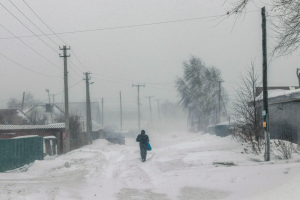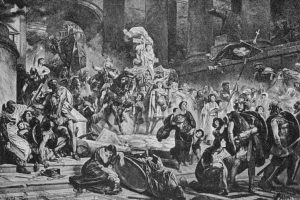Overcoming great obstacles, many Cubans are returning to the Catholic faith and helping renew the island’s church.
To this day Aldo Santos remembers with gratitude the frequent blackouts he experienced as a child in his native town of Holguín in northeast Cuba. Everyone in the neighborhood would come out of their house to gaze at the stars.
He would look up and ask his father about the moon and the planets and about a future full of dreams. He learned that even galaxies die, and it was then that he began to understand something about the end of things.
Now, at 39, Santos is a renowned cardiologist at the Lenin Hospital of Holguín and he deals with death quite often. When excessive work and stress make him feel distant from his wife and three children, and even from God, he turns off the lights and invites his family to look up to heaven. In the darkness, surrounded by his own, he says he is able to reconnect to what is essential.
Connecting to what is essential is an important survival strategy for people in Cuba, and it involves more than being connected to family.
The first such essential for Cuban families today is “putting food on the table,” says Father Vicente Llambias, an Argentinian missionary who has served for five years in the Diocese of Holguín. The second is worrying about having a job and about the future: “People know that changes are coming, and they worry about how they will be affected.”
Another great need is transportation. “People leave each morning, and they wait for hours by the road, trusting that God may help them reach their destination,” Llambias says. Housing is also a big problem because frequently four generations share the same dwelling. “In Cuba there is no private life or respect for it,” he explains.
But Llambias has also sensed a deeper general sadness and a certain pessimism among Cubans about improving their lot.
Santos agrees with this assessment. He must confront the same challenges in his daily life. To get to his job, the cardiologist rides a bicycle with a sidecar. The parking area at the hospital and the streets of Cuban cities are full of similar creatively constructed vehicles.
Cuba has a dual money system. The official currency is the Cuban peso (CUP). Salaries range from 400 to 800 pesos—the equivalent of $20 to $36 a month—including for doctors.
In 2004 the Cuban Convertible Peso (CUC) was introduced. It is almost equal in value to the U.S. dollar. Although today many essentials must be bought with the CUC, it is available only to those who receive dollar remittances from their families abroad, are tipped by tourists, or who participate in “international missions.”
Such missions are arranged through agreements with other countries—primarily in Latin America and Africa—that may pay the Cuban government large dollar amounts for each worker. The Cuban worker receives about 500 CUC a month; the rest goes to the government. Some 75 percent of the Cubans working abroad in these missions are medical personnel.
Santos says that, despite the separation from the family, it is a great improvement for the worker.
In Cuba’s “golden era” of medicine in the 1970s and ’80s—with large subsidies from the Soviet Union and an abundance of doctors—the system was working, he says. Today all citizens still have universal access to medical services through their neighborhood clinics, but, with many doctors serving abroad, there are long waiting lists to see specialists, who have an overload of work.
Serving in such international missions can be a rewarding experience. It was for Marilyn Aldana, who returned in January from a two-year mission in Venezuela. She was promoting choral music in a Caracas barrio “among poor people who have no access to this type of music or dance and theater.”
Aldana, who directs the choral group Orfeón Holguín, is a practicing Catholic who sings at liturgical events in the city’s cathedral. “The Cuban woman is very enterprising, a fighter, and does not give up easily,” she says. Although life in Cuba is a continuing challenge, for her “music is a cure for the soul.” Her faith has sustained her, and she has never denied it, even when it could have caused her problems.
Choosing a Christian life
In 1992, after three decades of religious discrimination and official atheism, Cuba was declared a secular state. Since then many Catholics have journeyed back to the church. Many had denied or hidden their faith and that of their children in an effort to protect them from persecution or from being barred from certain studies or advancement in their jobs.
To Santos, “Being a Christian is one of the best resources that allows a Catholic professional to rise above difficulties.” He believes that today the church should focus on the formation of the laity. “The church cannot solve the social and economic problems, but it can motivate the laity to assume their role in society.” He says this requires great love for the country. “One cannot do anything without love, without forgiveness and reconciliation.”
The father of three young children, Santos worries about the values his children will learn in their schools, “given that the school system is deeply ideological.” He is particularly concerned about counteracting values such as hate for the enemy or justifications for the use of violence.
“How can we teach our children about truth or freedom without fear that they will get in trouble in school?” he wonders. And he knows that some of what is taught at school may also contradict Christian views on sexuality and the family.
But some things may now be changing. “The family had been kept away from the schools, but now the schools are trying to get the family involved,” says Carlos Carvallo, a teacher in the city of Sagua de Tánamo, about 90 miles east of Holguín. The school system has created schools for parents, where they discuss academics or topics related to formation.
“We teach parents how to educate their children at home,” he explains. “We talk about dealing with young people and topics related to the family and sexuality.”
In Cuba all schooling—from kindergarten to university—is run by the state, at no cost to the parents. In 1961, after the failed Bay of Pigs invasion by the United States, the Castro revolution took a definite turn toward Marxism. About 1,250 private schools—including 250 Catholic schools—were nationalized. Their buildings were confiscated. Access to certain university careers was denied to those who confessed their religious faith—a practice that was phased out in 1992.
Today the Catholic Church does not have schools, but it has not abandoned its teaching and formative role. Since the 1980s Catholic dioceses have been organizing centers for formation.
One example is the diocesan Summer Schools for Educators, which seek to support the vocation of Catholic teachers working in public schools. Carvallo attended one of these last year. “Now we use some of the topics in our meetings with parents, and they show great interest in them.”
Carvallo also works in family ministry in his parish of Blessed Trinity. The group has grown to 46 couples, who have meetings and workshops. But until last summer the group could not meet at the parish church because it had no roof.
In the 1950s the parish was in the middle of building a larger church, when, just before the roof was to be put in place, the Cuban revolution occurred. The church remained uncovered for more than half a century. Rain or shine, liturgies took place under the open sky.
In the summer of 2011 the government finally approved the building permits and the church was completed. To celebrate, the parish roasted a pig and the whole town joined in. “People are coming back, especially young ones,” Carvallo says. “I foresee a good future for the Catholic Church in Cuba.”
Community values
One way this future is being built is through small faith communities, says Colombian Father Jaime González Lopez Mesa, who has served for 16 years in Cuba. He is pastor of Holguín’s cathedral parish and has seen how in these small communities people have a personal encounter with Jesus that changes their lives. “With the support of the community they discover new values. A new Cuban church is emerging.”
Since 1961 the Cuban government has not allowed any construction of new churches. But the church is building small communities that meet in people’s homes, which become known as houses of prayer or mission houses.
Marist Brother Carlos Martínez Lavin works at the national level in the formation of these communities. He estimates that there are some 2,500 on the island. He believes that Cuba may be the country that is best implementing the call to mission issued by the 2007 Latin American bishops’ meeting in Aparecida, Brazil.
But despite the greater numbers of people awakening to the faith, Cuba is lacking in religious and priestly vocations and depends on missionaries from other countries. For Cuba’s population of almost 12 million there are only 472 priests, 292 of whom are foreign-born. Among the 559 women religious, 361 are from abroad.
The Diocese of Holguín—Cuba’s largest in territory and the second in population (of more than 1.5 million)—has only 34 priests, 18 of them from other countries. Of Holguín’s 44 women religious only one is Cuban.
With this scarcity of personnel, priestly life demands great dedication, says Cuban priest Father Inocente Fernández Martínez.
“If a priest does not live and suffer with the people, he will achieve very little,” he says. Fernández was ordained at age 40, after returning to the church in the 1990s. He was inspired to do so after reading the pastoral letter of the Cuban bishops El amor todo lo espera (“Love hopes for everything”).
With the fall of the Soviet bloc and the loss of its subsidies, Cubans suffered great shortages. The bishops’ letter, issued on Sept. 8, 1993, the Feast of Our Lady of Charity, denounced “exasperating government policies,” among them the official ideology, the limitations to freedom, excessive control, and the high numbers of people imprisoned for political, ideological, or religious ideas.
The official media criticized it as a “stab in the back,” but for Fernández it was a push to come back to the church. He believes that priests play an important role in Cuba, “lifting the people’s hope” in a country with no personal freedoms and great economic challenges.
Papal encouragement
When Archbishop Dionisio García Ibañez of Santiago de Cuba welcomed Pope Benedict XVI on his “Pilgrimage of Charity” in late March, he acknowledged that Cubans want to achieve “well-being and justice for all” but “have different criteria about the path to reach a better future.” He also stressed the need “to overcome the barriers that separate Cubans” and asked the pope to pray “that Cubans may not be afraid to seek solutions to our national problems with the participation of all in a spirit of mercy, dialogue, mutual respect, and mutual reconciliation.”
The pope did pray for Cubans at the Shrine of Our Lady of Charity of El Cobre, where the patroness of Cuba is venerated, about seven miles from Santiago. Her image was found 400 years ago floating in the Bay of Nipe on the northern coast near Holguín. To commemorate the anniversary, the Cuban church is currently celebrating a Marian Jubilee Year that will end in January 2013.
While in Cuba, Benedict recalled the 1998 visit of Pope John Paul II to the island and its profound impact on the “soul of all Cubans.” He said it marked a new era in the relations of the church with Cuban society and government. That new era has become more obvious since 2008, when Fidel Castro retired and handed power over to his brother Raúl, and particularly since last December, when Cuba’s bishops helped to mediate the release of almost 3,000 Cuban prisoners.
Bishop Emilio Aranguren Echeverría of Holguín sees the church in Cuba as living a spirituality of small, anonymous, and gradual gestures. He says that “living out these values with perseverance and determination motivates everyone to carry the cross and give fruits of an increasing presence in society.”
Particularly when compared with the limitations of the church in the 1970s, these fruits are hard to miss in Cuba today.
This article appeared in the June 2012 issue of U.S. Catholic (Vol. 77, No. 6, pages 31-35).
Image: Araceli M. Cantero












Add comment